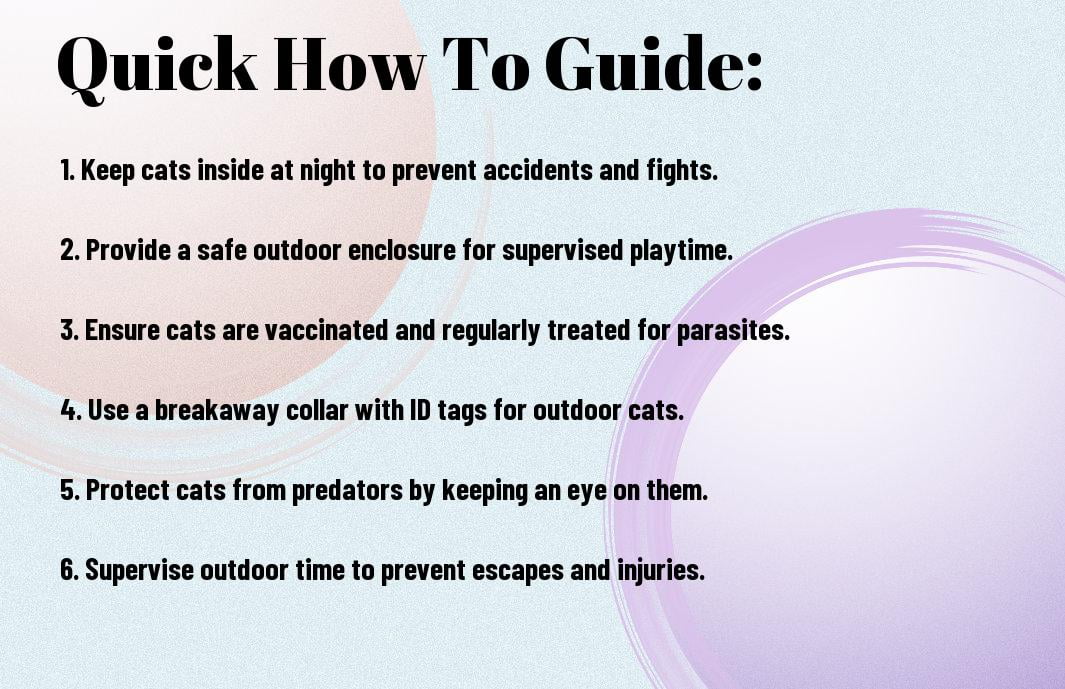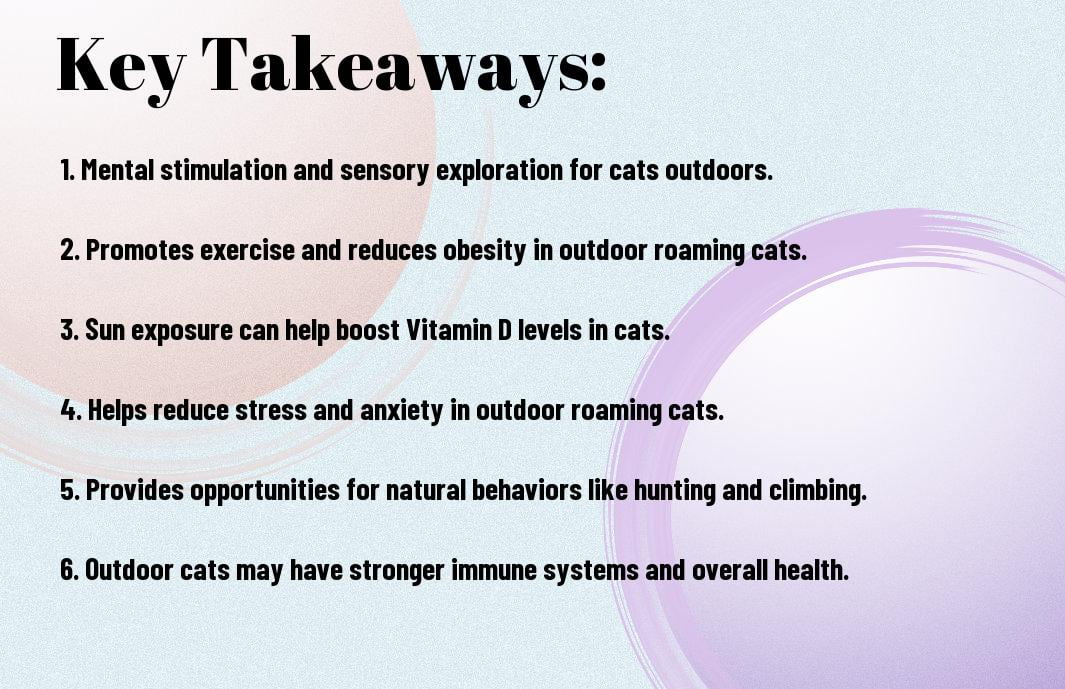Over the years, many cat owners have chosen to allow their feline companions the freedom to roam outdoors. While the fresh air and exploration can be beneficial for cats, there are also numerous risks that come with outdoor living. In this guide, we will outline some common dangers that outdoor cats may face and provide tips on how to keep your furry friends safe and sound.

Identifying Common Outdoor Risks for Cats
Predators and Other Wildlife Encounters
Little do many cat owners realize the dangers that lurk outdoors for their beloved feline friends. When allowing your cat to roam outside, you expose them to potential encounters with predators and other wildlife such as coyotes, foxes, and even birds of prey. These predators may see your cat as prey, leading to potentially fatal confrontations.
Traffic and Accidental Injuries
You must be vigilant when it comes to the risks of traffic and accidental injuries for outdoor cats. Cats that roam freely are susceptible to being hit by vehicles, leading to severe injuries or even death. Accidental injuries from falls, fights with other animals, or getting trapped in dangerous areas are also common outdoor risks for cats.
Accidental injuries can happen in an instant and have devastating consequences. Even the most cautious cat can find themselves in a precarious situation, so it is crucial to be aware of the potential dangers that your cat may face while outdoors.

Disease Prevention and Health Risks
Common Diseases for Outdoor Cats
Diseases pose a significant risk to outdoor cats, as they are more exposed to various pathogens and parasites. Common diseases that outdoor cats may encounter include feline leukemia virus (FeLV), feline immunodeficiency virus (FIV), upper respiratory infections, and parasites like fleas, ticks, and worms. These diseases can have serious health implications and may even be life-threatening if left untreated.
Vaccinations and Regular Health Check-ups
With vaccinations and regular health check-ups, you can significantly reduce the risk of your outdoor cat contracting common diseases. Vaccinations help protect your cat against deadly viruses like FeLV and FIV, while regular check-ups allow your vet to monitor your cat’s health and address any emerging issues early on. It is vital to follow your vet’s recommendations for vaccination schedules and ensure that your cat receives preventive care to maintain their well-being.
Common vaccinations that outdoor cats should receive include vaccinations for rabies, feline distemper, and feline leukemia. By staying up to date on vaccinations and scheduling routine check-ups, you can help safeguard your outdoor cat’s health and provide them with a better quality of life.
Human-Related Dangers
Risks of Poisoning and Toxic Substances
Little do many cat owners realize the potential dangers lurking outdoors for their furry friends. Cats are curious creatures by nature, and this can lead them to investigate substances that may be harmful to them. Common risks of poisoning for outdoor cats include exposure to toxic plants, chemicals like antifreeze, pesticides, and even certain human foods like chocolate and onions.
Understanding and Mitigating the Threat of Animal Cruelty
Toxic behaviors towards animals, including cats, are unfortunately a reality. Understanding the warning signs of animal cruelty can help cat owners protect their pets from potential harm. Signs of animal cruelty can include unexplained injuries, the animal displaying fear or aggression towards humans, and keeping an animal in unsanitary or inadequate living conditions.
To mitigate the threat of animal cruelty, it’s crucial for cat owners to report any suspected cases to the appropriate authorities, such as local animal control or law enforcement. By taking action against animal cruelty, we can help ensure the safety and well-being of our beloved feline companions.

Environmental Factors and Weather-Related Risks
Now, outdoor cats face a variety of risks due to environmental factors and weather conditions. It is vital for cat owners to be aware of these risks and take necessary precautions to keep their feline companions safe.
Extreme Temperatures and Weather Conditions
If you allow your cat to roam outdoors, it is crucial to consider the impact of extreme temperatures and weather conditions on their well-being. Cats can suffer from heatstroke in hot weather and hypothermia in cold weather. To help protect your cat from these risks, provide adequate shelter, access to fresh water, and monitor their outdoor time during extreme weather conditions.
| Extreme Heat | Extreme Cold |
| Provide shade and water | Insulate shelters with blankets |
| Never leave your cat in a hot car | Check for signs of frostbite |
Though cats are resilient animals, they are still susceptible to the dangers of extreme weather conditions. It is important to be vigilant and mindful of their well-being when they are outdoors.
Safe Shelter: Providing an Outdoor Refuge
Any responsible cat owner should ensure their outdoor cat has access to safe shelter at all times. This shelter should offer protection from the elements, including rain, wind, and extreme temperatures. Providing a cozy shelter will give your cat a safe place to retreat to when needed.
For instance, you can create a simple shelter using a sturdy box or crate with a soft bed inside. Place the shelter in a quiet and secure location where your cat feels comfortable. Regularly check the shelter for any damages or signs of wear and tear, and make necessary repairs to keep it secure and safe for your cat.
Keep in mind that outdoor cats are at risk of encountering navigational hazards that could lead to them getting lost. Cats are curious creatures by nature, and their exploration instincts may sometimes cause them to wander away from home. It’s crucial for cat owners to be aware of potential dangers and take precautions to prevent their feline companions from getting lost.
Importance of Identification: Collars and Microchips
While it’s impossible to predict when a cat might stray from familiar territory, having proper identification can greatly increase the chances of a lost cat being reunited with its owner. Collars with ID tags that include the cat’s name and a contact number are a visible means of identification for those who may find a lost cat. Additionally, microchipping your cat provides a permanent form of identification that cannot be lost or removed. In the unfortunate event that your cat does get lost, these identification methods can be lifesaving in helping them find their way back home.
Training Tips to Help Your Cat Navigate Safely
Any cat, regardless of age, can benefit from basic training to help them navigate outdoor spaces safely. Start by leash training your cat in a controlled environment before allowing them to explore outdoors freely. Use positive reinforcement techniques such as treats and praise to encourage good behavior and discourage wandering off. Gradually introduce your cat to different outdoor environments, always keeping a close eye on them to prevent any potential risks.
- Teach your cat to respond to a specific recall command, such as their name or a whistle, to help them come back to you when called.
- Provide visual markers, such as brightly colored flags or landmarks, to help your cat orient themselves in unfamiliar surroundings.
This proactive approach to training your cat can help reduce the chances of them getting lost and potentially facing dangerous situations while outdoors. Recall, prevention is key when it comes to keeping your outdoor cat safe and secure.
How to Create a Safe Outdoor Space for Your Cat
Enclosed Outdoor Environments: Catio and Fenced Yards
Allowing your cat to have access to the outdoors can greatly enrich their quality of life, but it’s important to take precautions to ensure their safety. Even the most independent of cats benefit from having a protected space to explore outside. One popular option is to create an enclosed outdoor environment, such as a catio or a fenced yard, where your cat can safely experience the outdoors.
Enclosed spaces like catios or fenced yards provide a secure area for your cat to enjoy the sights, smells, and sounds of nature without the risks associated with roaming freely outdoors. These areas can be customized to include shelves, ramps, hiding spots, and interactive toys to keep your cat entertained and engaged while ensuring their safety.
Supervision Strategies: Harness Training and Walking Your Cat
Supervising your cat while they are outdoors is another way to keep them safe. An excellent method for this is harness training your cat and taking them for supervised walks. Cats can learn to enjoy on-leash outdoor adventures with the proper training and patience.
Harness training provides a controlled outdoor experience for your cat while allowing them to explore new surroundings under your watchful eye. This strategy is particularly beneficial for indoor cats who may be curious about the outdoors but lack the street smarts necessary to navigate potential dangers. Remember to always use a properly fitted harness and leash designed for cats to keep your feline friend secure during outdoor excursions.
Safe
It’s crucial to prioritize your cat’s safety when allowing them outdoor access. By creating a secure outdoor space or employing supervision strategies like harness training, you can provide your cat with the stimulation of the outdoors while minimizing the risks associated with free-roaming. Always supervise your cat during outdoor activities and be prepared to intervene if any potential dangers arise. With these safety measures in place, your feline companion can enjoy the best of both worlds – the thrill of the outdoors in a secure and protected environment.
Alternative Solutions and Safe Exploration
Indoor Enrichment for the Outdoor-Loving Cat
Exploration is a natural behavior for cats, even those who are used to the great outdoors. To satisfy their need for stimulation and adventure, consider creating an enriching environment indoors. Provide climbing structures, hiding spots, interactive toys, and puzzle feeders to mimic the outdoor experience. By engaging your cat in play and mental stimulation, you can help them stay happy and content in a controlled indoor setting.
Leash Training and Controlled Outdoor Adventures
If you still wish to provide your outdoor-loving cat with some outdoor access, leash training is a safe and effective way to do so. Start by acclimating your cat to the harness indoors, allowing them to get comfortable with the feeling before venturing outside. Gradually introduce them to the sights, sounds, and smells of the outdoors while remaining in control of their environment. With patience and positive reinforcement, leash training can allow your cat to explore the outside world safely.
Plus, supervised outdoor adventures in a cat enclosure or “catio” can provide a compromise between indoor safety and outdoor exploration. These enclosed spaces allow your cat to experience the outdoors while being protected from potential dangers such as predators, traffic, and other outdoor hazards.
Final Words
Taking this into account, it is important for cat owners to be aware of the common risks that outdoor cats face and take steps to minimize them. By keeping your cat indoors, providing a safe outdoor enclosure, or supervising outdoor adventures, you can help protect your feline friend from dangers such as traffic accidents, predators, parasites, and diseases. Regular veterinary check-ups, vaccinations, and proper identification also play a crucial role in ensuring your cat’s safety and well-being. Be mindful of, a little extra care and precaution can go a long way in keeping your outdoor cat safe and happy.
FAQ
Q: What are the common risks for outdoor cats?
A: Common risks for outdoor cats include traffic accidents, exposure to toxins, fights with other animals, and getting lost or stolen.
Q: How can I protect my outdoor cat from traffic accidents?
A: To protect your outdoor cat from traffic accidents, ensure they have a visible collar with ID tags, consider microchipping, and provide a safe outdoor enclosure or catio.
Q: What toxins should I be aware of that can harm outdoor cats?
A: Toxic substances such as antifreeze, certain plants like lilies, insecticides, and rodenticides can be harmful to outdoor cats. Keep these substances out of reach.
Q: How can I prevent fights between my outdoor cat and other animals?
A: To prevent fights between your outdoor cat and other animals, spay or neuter your cat to reduce aggression, keep them indoors during peak wildlife hours, and provide a safe outdoor space for them to roam.
Q: What should I do if my outdoor cat goes missing?
A: If your outdoor cat goes missing, search your neighborhood, post flyers, notify local shelters and veterinary clinics, and utilize social media platforms to spread the word and help in the search efforts.















